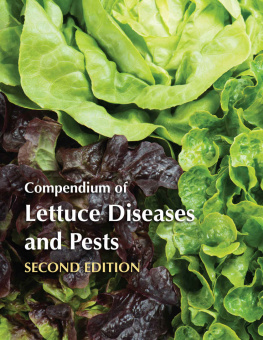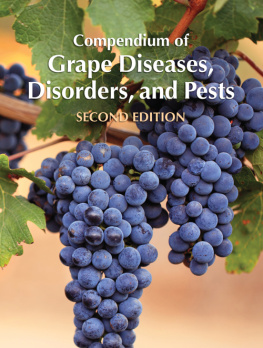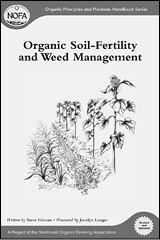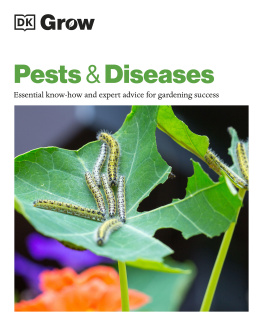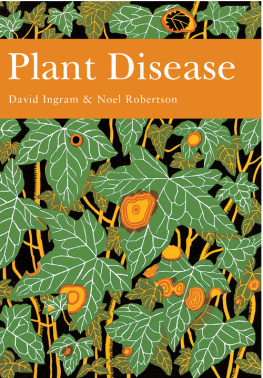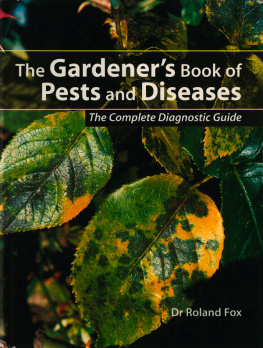APS PRESS has designed this compendium series of practical guidebooks to offer convenient help in identifying, managing, and preventing the diseases of major crop plants. This compendium serves the interests of growers, consultants, and researchers. Financial sponsors allow these books to be more affordable to a wide audience.
APS PRESS thanks the following sponsors for their financial support of this compendium.
Rijk Zwaan USA, Inc.
Vanguard Seed, Inc.
Compendium of Lettuce
Diseases and Pests
SECOND EDITION
Edited by
Krishna V. Subbarao
University of California, Davis
Davis, California, U.S.A.
R. Michael Davis
University of California, Davis
Davis, California, U.S.A.
Robert L. Gilbertson
University of California, Davis
Davis, California, U.S.A.
Richard N. Raid
University of Florida
Belle Glade, Florida, U.S.A.

The American Phytopathological Society
St. Paul, Minnesota, U.S.A.
Front cover images :
Top, butterhead lettuce; bottom left, red leaf lettuce; bottom right, green leaf lettuce (Iryna Denysova/Shutterstock.comReproduced by permission)
Reference in this publication to a trademark, proprietary product, or company name by personnel of the U.S. Department of Agriculture or anyone else is intended for explicit description only and does not imply approval or recommendation to the exclusion of others that may be suitable.
Library of Congress Control Number: 2016963488
International Standard Book Numbers:
Print: 978-0-89054-577-5
Online: 978-0-89054-578-2
Mobi: 978-0-89054-579-9
ePub: 978-0-89054-580-5
1997, 2017 by The American Phytopathological Society
First edition published 1997
Second edition published 2017
All rights reserved.
No portion of this book may be reproduced in any form, including photocopy, microfilm, information storage and retrieval system, computer database, or software, or by any means, including electronic or mechanical, without written permission from the publisher.
Copyright is not claimed in any portion of this work written by U.S. government employees as a part of their official duties.
Printed in the United States of America on acid-free paper.
The American Phytopathological Society
3340 Pilot Knob Road
St. Paul, Minnesota 55121, U.S.A.
Preface
Since the first edition of Compendium of Lettuce Diseases was published in 1997, consumer demand for more nutritious salad products has brought momentous changes in the types of lettuce produced and in the methods of cultivating them. For example, crisphead lettuce was the predominant type grown until the 1990s, when production shifted to the cultivation of romaine, leaf, and baby leaf types of lettuce because of the popularity of value-added salad mixes with longer shelf lives. This shift necessitated a change in lettuce production from narrow beds with two seed lines to wider beds with five or six seed lines and an associated 2050% increase in plant density. Changes in the types of lettuce grown and the methods of producing them have also brought new challenges to disease and pest management in lettuce production. Since publication of the first edition, many new diseases have been reported that threaten lettuce production.
Compendium of Lettuce Diseases and Pests, Second Edition , provides a comprehensive account of the diseases, pests, and abiotic disorders of all types of lettuce along with practical guidelines for their management. This compendium will be useful to plant pathologists, entomologists, breeders, seed company personnel, crop production specialists, growers, diagnosticians, students, regulatory personnel, crop consultants, educators, researchers, Extension personnel, and others involved in the diagnosis and management of lettuce diseases, pests, and disorders throughout the world.
The content of this new edition is significantly expanded and organized as follows:
- The addresses lettuce production, lettuce breeding, applications of biotechnology and genomics to improve disease resistance, lettuce seed germination under stress, lettuce diseases and disorders, and lettuce-associated microbiota. It also identifies the food safety issues that have emerged as a major concern for the lettuce production industry since the mid-2000s.
- , Infectious Diseases, outlines types of pathogens and includes sections on diseases caused by fungi and oomycetes, bacteria, phytoplasmas, viruses, nematodes, and a parasitic plant.
- , Arthropod Pests, is new to this edition and identifies 28 pests of lettuce in the classes Insecta, Symphyla, Arachnida, and Malacostraca. (The role of insects as vectors of viruses and phytoplasmas is discussed in Part I.)
- , Injuries and Abiotic and Noninfectious Diseases and Disorders, includes sections on mineral deficiencies and toxicities, noninfectious physiological disorders, weather-related injury, ammonium toxicity, soil pH and salinity, and bird damage. A comprehensive table with related images reviews foliar symptoms of herbicide injury by herbicide family, mode of action, and chemical name and includes notes about related factors and prevention. In this edition, information related to herbicide injuries is provided in one place.
- , Postharvest Diseases and Disorders, addresses bacterial soft rot, russet spotting, gray mold, brown stain, pink rib, and other diseases and disorders that affect harvested lettuce.
The description of each disease includes a general overview of its importance and world distribution, the most diagnostic symptom or symptoms, the causal organism or agent, the disease cycle and epidemiology, strategies for management, and references that direct readers to additional information. The management strategies presented include all relevant and practical tactics; they apply to most lettuce production areas and can be used to develop integrated pest management (IPM) approaches. This allows for the development of IPM packages for different locations and types of production with maximum flexibility. (Local Extension agents and crop-protection specialists should be consulted for specific recommendations on fungicides or pesticides.) The text is illustrated with 209 imagesmost of them new to this edition.
Also new to this edition is an appendix that identifies the common names of diseases of lettuce and their pathogens. The same content is available on the website of The American Phytopathological Society in the section Common Names of Plant Diseases. Any updates that are subsequently made to the taxonomy and nomenclature will be reflected on the website. Throughout the text, the common names of diseases and pests are generally provided, along with the currently accepted scientific names. Authorities for the scientific names of pathogens are included in the appendix. Within the text, plants are mostly referred to by their common names; scientific names are also provided for those plants whose common names may be unfamiliar to readers.
The California Leafy Greens Research Board served as a valuable resource for many of the topics in this compendium and deserves special thanks. The financial sponsors listed inside the front cover are also gratefully acknowledged for their support of this book. In addition, the University of California and the University of Florida provided us with the facilities and time to complete this project.

